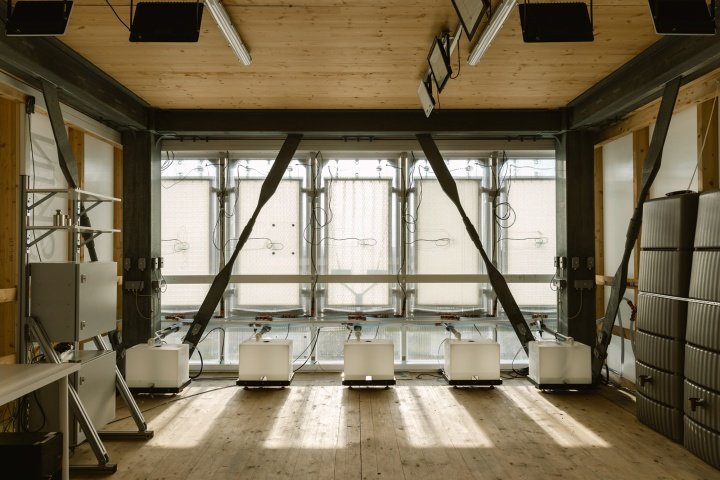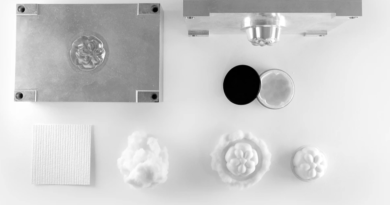Innovative Façade Design for Climate Resilient Buildings: Reducing Heat Islands and Flood Risks
The University of Stuttgart’s Collaborative Research Center 1244 has unveiled HydroSKIN, the world’s first hydroactive building façade made with textiles that not only stores rainwater but also uses it to cool down hot building exteriors.
On October 4, 2022, the Collaborative Research Center 1244 presented a groundbreaking solution to two pressing urban problems: the overheating of cities and the damage caused by flood events. The solution comes in the form of a hydroactive facade called “HydroSKIN,” which stores rainwater in textile elements and uses it for evaporative cooling on hot days. With urbanization and densification on the rise, there is a growing need for sustainable design solutions to reduce the impact of buildings on the planet’s heating. The HydroSKIN facade reduces heat islands caused by glass facades that absorb and trap heat, while also reducing flood damage by absorbing and reusing rainwater.

Need for sustainable building solutions
As cities grow and become more densely populated, the issue of urban heat islands is becoming increasingly urgent. In Singapore, for example, built-up areas can be up to 10 degrees hotter than parks due to the fact that sealed surfaces allow only 10 percent of water to evaporate, leading to a lack of natural cooling. This, coupled with the increasing risks posed by flooding caused by heavy rain, means that new solutions are needed to mitigate the impact of climate change on our cities.
Minimal resource requirements
Christina Eisenbarth, a Research Assistant at the University of Stuttgart’s Institute of Lightweight Structures and Conceptual Design (ILEK) and the inventor of the hydroactive façade, proclaims it as a milestone in the adaptation of the built environment to urgent challenges. According to Prof. Werner Sobek, former spokesperson of the Collaborative Research Center 1244 Adaptive Skins and Structures for the Built Environment of Tomorrow, upgrading the sewage system to control increasing water masses would require an enormous construction effort and is not a sustainable solution. He suggests that the hydroactive elements of the façade, which have minimal resource requirements, are an effective solution for neutralizing the urban heat island effect.

Composition and layers
The HydroSKIN façade is composed of multiple layers of textiles that collect and evaporate water. The first layer is a water-permeable mesh or knitted fabric on the outside that filters out impurities and insects while letting water in. The second inner layer is a water-transporting spacer fabric with pile threads that enhance water mobilization and provide a large surface area for air circulation, which enhances evaporation. The system may include a third layer to optimize water storage and evaporation performance. Finally, the fourth layer, located on the inside, is a water-bearing foil that facilitates drainage and collection.
Assembly
The HydroSKIN facade’s layers are assembled by a force fit and fixed into a frame profile using a waterproof Keder fabric. The thickness of the envelope system, which can range between 20 and 60 mm, depends on the environmental conditions and performance requirements. The depth of the frame profile’s water supply and discharge conduits varies from 50 to 100 mm, depending on the wind-driven rain yields. High-rise buildings are ideal for hydroactive facades due to their large facade surfaces and the angle at which rain hits the facade at higher elevations. From a height of approximately 30 meters, more rain can be absorbed by the facade than by a roof surface of the same size. The high wind speeds also increase the evaporative-cooling effect, creating a cool air flow that moves downward into the urban space.
Ideal placement
The first HydroSKIN elements are currently being tested on the world’s first adaptive high-rise building on the Vaihingen Campus at the University of Stuttgart, which is the flagship project of the Collaborative Research Center 1244 and one of the selected projects for the International Building Exhibition (IBA). “The results are promising. In laboratory tests, we were able to demonstrate a temperature reduction of about 10 degrees due to the effect of evaporation. Initial measurements on the high-rise building from early September suggest that the cooling potential is even significantly higher,” explains Christina Eisenbarth. Researchers have also tested their concept in the lab and on buildings in Stuttgart and Singapore, with Eisenbarth currently in Australia preparing to test HydroSKIN on buildings in Sydney. With the positive results so far, the potential for widespread application of HydroSKIN in high-rise buildings could revolutionize building cooling systems and enhance urban environments.




